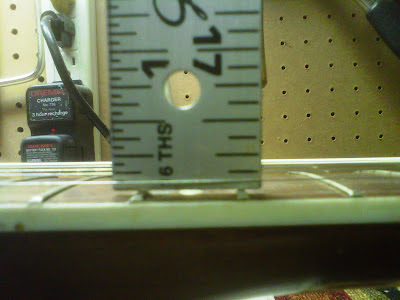I can still feel the breeze
that rustles through the trees
And misty memories of days gone by.
that rustles through the trees
And misty memories of days gone by.
The answer to the question the Brothers Gibb asked in this song sure wasn't a neck reset, but that's all this old guitar needed to get her high action and intonation under control. With the latest set of oak shims attached to the heel, and very little sanding, I placed her neck back. The dovetail joint closed up better this time, leaving no sign of a gap at the heel cap. With her saddle in place, I laid a straight edge across the upper frets to check the projection at the saddle, and found that it was just under a 1/16 of an inch below the top of the saddle.
I restrung her and checked that same projection with each sting I added, and noticed a little change with each string. With all six strings on and tuned, I was very pleased to find the projection only increased to about 1/8 of an inch. I was even more pleased to find that her action was at 1/8 inch on the bass side and 1/16th of an inch on the treble side.
She played nicely and didn't need a truss adjustment at this point. Although her action was a bit more than I would like on the low E side, there was still plenty of height left in the saddle to allow for dropping that side down to 3/32 of an inch. I decided to leave that for next time, after letting her acclimate to the conditioned house air for at least a day to be sure her neck joint was stable. So, I moved on to addressing a simpler problem.
All that work resetting the neck, although great for reducing her action, left a good-sized pie shape gap between the high end of her fretboard and her already sunken front panel. Besides the aesthetics, I was worried that gluing the end of the fretboard to the front panel would stress the fretboard and binding to the point of cracking at best, lead to problems with the 14th and 15th frets being loose, and that it would leave a very obvious gap between those two frets.
The solution I came up with was to install a shim between the top plate and the end of the fret board. I took measurements and found that the original bridge plate was just the right thickness for making the shim. That also seemed an appropriate way to make use of an original part of this old guitar. After cutting and gluing up two pieces to get the width I needed, I tapered the shim on one side with a belt sander to match the profile of the gap.
When the shim fit, I traced the outline at the fretboard. Using a coping saw, I cut the shim down to size.
With some sanding around three edges, the shim was done for now. I left enough wood for final sanding during reassembly, and put the shim aside before putting this old guitar back in the house. After two nights with no change in action, I do dare to call this reset a success! This left just enough time to play a few songs before putting her and myself to bed for the night.









No comments:
Post a Comment